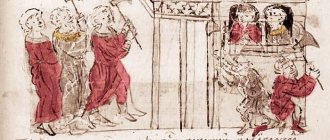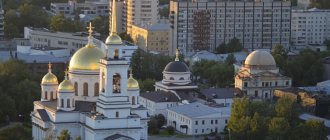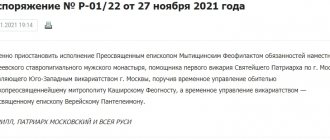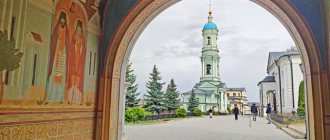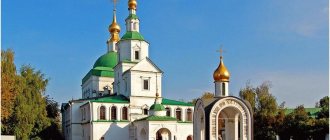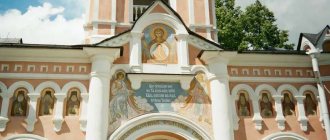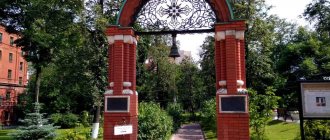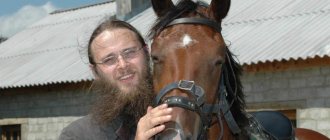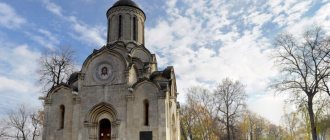Story
The Novospassky Monastery, dedicated to the Savior, became the first monastic monastery in the capital. It was founded in the 13th century by Prince Daniil on a small hill at the confluence of the Khudenets River and the Moscow River. The son of Prince Daniel, John Kalita, moved the Spassky Monastery to the Kremlin in 1330. During the invasion of the Tatar Khan Takhtomysh, it was plundered and burned, and the rector, Archimandrite Simeon, was killed. At the end of the 15th century, the monastery was moved to Krutitsky Hill, in Vasilievsky Camp on the river bank.
Based on its location, the monastery was named Spas na Novy, that is, Novospassky. The Transfiguration Church, also known as the Savior on Bor, was left in the old place in the Kremlin. Under Ivan the Terrible, the monastery became the most important defensive point, repelling enemy attacks on the city. During the time of Tsar Mikhail Fedorovich Romanov from 1640 to 1642, the wooden fence was replaced by a stone one with loopholes.
Residential stone premises and a temple are being built in the name of the Sign of the Mother of God - the ancestral shrine of the Romanov boyars. A tented bell tower with a temple in the name of Saint Sava is being built. In the last years of his reign, Mikhail Fedorovich began to build the Transfiguration Cathedral and the Intercession Church.
In 1647, a wonderful miraculous image of Christ the Savior was brought here, which the kings began to worship. The image disappeared with the arrival of the Bolsheviks. In the 17th century, criminals and heretics were imprisoned here. Among the latter was the Monk Dionysius, rector of the Trinity-Sergius Lavra, who was starved and smoked. Peter the Great treated the monastery with respect. Although at that time there was a war with Sweden and excess bells were poured into cannons, a large bell was poured for the Spassky Monastery. Tsar Fyodor Alekseevich distributed alms here. Princess Sofia and Ivan Alekseevich visited the monastery. After Peter's times, the monastery fell into decay. It suffered from the Moscow fires, and under Catherine II it lost its estates. During the war with Napoleon it was destroyed. The soldiers wanted to blow it up, but miraculously she managed to survive.
In the 19th century, when Archimandrite Agapit of Vvedensky was the rector, the spirit of monasticism was raised and the monastery became a model for other monasteries. At the beginning of the 20th century it was a center for religious and moral education of the population. Missionary studies and education of the illiterates were carried out here. The Society of Church Singing and Temperance worked. On Sundays and holidays the churches were overcrowded.
In 1918 the monastery was closed. The area was used as a prison. Most of the necropolis was destroyed. The churches housed the archives of the NKVD of the Moscow region, warehouses and vegetable storage. The plan was to blow up the buildings. The Great Patriotic War prevented this. Since 1968, restoration of the external appearance of the temples began. On December 4, 1990, the monastery was returned to the Patriarchate and began to be restored.
Tours of the monastery
You can independently explore the monastery churches only during morning and evening services, which traditionally take place at 8:00 and 17:00 from Monday to Saturday and at 7:00, 9:00 and 17:00 on Sundays. There is also a tour service at the monastery. After pre-ordering, its staff will tell visitors in detail about the history and architectural ensemble of the sanctuary and introduce them to the exhibits of the monastery museum. The duration of the examination is 40-60 minutes, and the cost is 600 RUB for an adult, 500 RUB for a student and 400 RUB for a schoolchild.
Also on the territory of the monastery you can visit a bookstore that sells a variety of literature on religious philosophy, theology, religious studies, culture, history, art, as well as the lives of saints and martyrs.
It is important to follow the rules of visiting the monastery. Women should always cover their heads with a scarf or shawl. It is forbidden to enter the local temples in short shorts, miniskirts and clothes that reveal the shoulders.
Temples
Initially, the temple and other buildings of the Novospassky Monastery were wooden. In 1491, John the Third laid the foundation for a stone cathedral church in honor of the Transfiguration of the Lord. It stood until 1497. Then it was dismantled to the ground. In 1645–1647, over the graves of the Romanov boyars, at the expense of Mikhail Fedorovich and Alexei Mikhailovich, the Transfiguration Cathedral was built, a grandiose, solemn one, crowned with a mighty five-domed dome.
It was built in the image of the Assumption Cathedral and was only inferior to it in size. It preserves frescoes from the 17th century. A special feature of the Spassky Cathedral were the images below, at the base of the pillars of the cathedral porch, of the ancient Greek philosophers and sages Homer and Orpheus, Plato and others. By this, the artists wanted to say that the wisdom of even the greatest pagan sages never rose above the lower steps of the Christian temple. The new temple was the tomb of the Romanov family. The temple was consecrated in 1649. And a year later, at the expense of Prince Y.K. Cherkassky, in the northwestern part of the monastery, a hospital St. Nicholas Church was erected.
At the entrance we see a bell tower, the construction of which began in 1759 under Empress Elizabeth Petrovna. Its height is three meters less than the bell tower of Ivan the Great. The architect of the construction is Ivan Zherebtsov. The first tier contains the main entrance gate. In the second tier is the Church of St. Sergius of Radonezh.
The warm Church of the Intercession of the Holy Virgin was built at the expense of Tsar Alexei Mikhailovich the Quiet in 1673–1675. The temple was consecrated 3 times. For the first time - upon completion of construction - in 1675, in 1813 after the Patriotic War with Napoleon, and the third time - in 1997. It contained the miraculous icon of the Savior of Khlynovsky, brought from Vyatka.
The Church of the Icon of the Sign of Our Lady of the Novospassky Monastery was built in 1795 on the site of a church from the early 17th century according to the design of the architect E. Nazarov, assistant to V.I. Bazhenova. The Znamenskaya Church became the tomb of the Sheremetev counts. In this church there is the grave of Praskovya Kovaleva-Zhemchugova-Sheremeteva, the famous serf actress who became the wife of Count N.P. Sheremetev. In 1902, in the Transfiguration Cathedral, in the tomb of the Romanovs, a temple was built for the family’s heavenly patron, St. Roman the Sweet Singer.
Shrines of the Novospassky Monastery
The most revered shrines of the monastery, where thousands of pilgrims flock every year, include:
- the icon of the Mother of God “The All-Tsarina” in the Novospassky Monastery, which is a copy of the miraculous image kept in the Vatopedi monastery on the Greek Mount Athos;
- the icon “The Savior Not Made by Hands” is a copy of a relic that was lost during the years when the Bolsheviks came to power;
- belt of St. John of Kronstadt, who, with the help of prayer, performed more than one healing miracle during his lifetime;
- the Romanovsky bell weighing about 16 tons, which is a copy of the bell destroyed during the years of Soviet power;
- the five-tiered iconostasis of the Transfiguration Cathedral, which is decorated with the Smolensk Icon of the Mother of God, as well as images of Christ, the apostles, prophets and God the Father;
- 2 reliquaries with relics: the first contains the relics of the holy abbots of the monastery, the other - particles of the vestments of the Mother of God and Jesus, the Jerusalem Cross of the Lord, as well as the relics of the disciples of Christ, the great martyrs, the venerable Optina elders and other saints.
How to get to the Novospassky Monastery in Moscow by metro
It’s not difficult to figure out how to quickly get to the monastery complex by metro. You should get to the Proletarskaya or Krestyanskaya Zastava metro stations and walk about 500 m along 3rd Krutitsky Lane in the direction of Novospasskoye Shosse. At the intersection where you will find yourself in 10 minutes, the monastery buildings will already be visible.
The Novospassky Monastery in Moscow is one of the most significant symbols of Russian Orthodoxy, in which the atmosphere of past eras is clearly felt.
You can get comprehensive information about the history of the monastery and services on the website Novospassky-monastery.rf.
Sights of Moscow openmoscow.ru
Novospassky Stavropegial Monastery Peasant Square, 10, metro station "Proletarskaya", "Peasant Zastava"
History of the monastery until 1917. Monastery in the Soviet period. Revival of the monastery. Where is it located, how to get there, visiting rules
History of the Novospassky Monastery until 1917
Novospassky traces its history back to the oldest monastery in Moscow. The monastery in the name of the All-Merciful Savior - Spassky - was founded at the end of the 13th century by the holy noble prince Daniil of Moscow, the son of Prince Alexander Nevsky. Initially, it was located at the Serpukhov outpost, on the site where the St. Daniel Monastery is now located. The son of Saint Prince Daniel, John Kalita, around 1330, moved the Spassky Monastery to the Kremlin on Borovitsky Hill near the Grand Duke's Palace. The reason for the transfer was the piety of Grand Duke John Kalita, who wished “...to establish a monastery near himself, although he would always see you on patrol...”. He wanted to see not just a monastery next to him, but a well-maintained monastery with a large number of monks and newly rebuilt premises. The Nikon Chronicle testifies to this: “And the gathering of monks was many, and they loved that monastery more than other monasteries, and they often came to it for prayer with much humility and reverence... and a lot of alms and everything needed was given to the monks living there.” The Spassky Monastery was a place of pilgrimage for the Grand Dukes and their families, which was facilitated by the proximity of the monastery to the Grand Duke's palace and the absence of a temple in the palace itself. Here, until the 15th century, the Grand Dukes buried their wives and children. Representatives of the Moscow princely family were buried in the vestibule of the Spassky Cathedral, following the example of the ancient churches of Constantinople, where rulers were buried in the vestibules “as gatekeepers of the temple.” This part of the temple retained the original structure of the tomb until the end of the 19th century. John Kalita, who took monastic vows and schema at the Spassky Monastery before his death, was buried in the newly built Archangel Cathedral of the Kremlin, which became the tomb of the Moscow princes. The cathedral church of the old Spassky Monastery - the Cathedral of the Savior on Bor - the oldest of those that existed in Moscow at the beginning of the 20th century, stood in the courtyard of the Grand Kremlin Palace, but was barbarically destroyed in 1933. In 1382, during the invasion of Khan Tokhtamysh, the Spassky Monastery was plundered and burned, and its abbot, Archimandrite Simeon, was killed. With the assistance of Grand Duke Dmitry Donskoy, the monastery was restored.
In 1490, in connection with the construction of a new sovereign court, John III decided to move the Spassky Monastery from the Kremlin to the left bank of the Moscow River, near the palace of the Sarai and Podonsky bishops (now the Krutitskoe courtyard) to the Vasilievsky camp on the banks of the Moscow River. A secluded place on the coastal hill of the Moscow River, from where the Kremlin Hill was visible, was well suited for monastic life, so here, by order of John III, the brethren of the Spassky Monastery were housed in a built wooden monastery. After the transfer, the monastery began to be called Novospassky or the Monastery of the Savior on Novy, in addition, it retained its role as a royal chamber, the primary monastery.
In 1491, Prince John III allocated funds for the construction of a stone cathedral church in the name of the Transfiguration of the Lord. The Cathedral of the Transfiguration of the Savior on the New was consecrated on September 18, 1497 by Metropolitan Simon of All Rus'. Since its foundation, the Novospassky Monastery has become the burial place of noble boyar families, mainly the Romanovs. Already in 1498, Vasily Yuryevich Zakharyin-Koshkin, a Moscow boyar, brother of Roman Yuryevich Zakharyin, who gave the name to the future ruling dynasty of the Romanovs, was buried in the tomb under the cathedral. Under Ivan the Terrible, the monastery turned into a mighty fortress. The fortress log walls with towers were strengthened, an additional fort was built, fortified with an earthen rampart, tyn and surrounded by a ditch. The monastery became one of the outposts of Moscow from the south. He had to repeatedly defend the capital from Tatar raids. So, in 1521 he took part in repelling the raid of the Tatar Khan Makhmet-Girey, in 1571 - Khan Devlet-Girey, in 1591 - Kazy-Girey. At the alarm, the archers from the guard rooms climbed stone stairs in the thickness of the walls to the loopholes. At this time, the monks lit fires and prepared boiling water in vats to then pour it on the heads of the enemy. The enemies approaching the fortress were hit from the loopholes of the lower tier, the loopholes of the second tier of the fortress walls and towers struck the enemy with targeted fire, the loopholes of the third tier conducted crossfire. At the beginning of the 17th century, the monastery withstood the siege of Polish invaders. During the Time of Troubles, the monastery was devastated because there was a road near it along which crowds of Poles and Lithuanians passed. At this time, much of what was donated by Grand Duke John III was lost. At the walls of the monastery, militia soldiers were preparing for the final liberation of Moscow from the Polish-Lithuanian invaders. “At the walls of Novospassky in 1612, on Krutitsy, Prince Pozharsky and his faithful squad kissed the cross to save Moscow and lay down their heads for it.” At the beginning of the Time of Troubles in March 1606, by order of False Dmitry I, the bodies of Mikhail and Alexander Romanov, brothers of Fyodor Nikitich Romanov, who had by that time become Patriarch Filaret, who had suffered during the persecution of Boris Godunov, were brought from remote northern and Siberian forts to Novospassky. The bodies were buried in the cathedral church. A little earlier, the ashes of Vasily Nikitich Romanov were buried here. Mikhail Fedorovich Romanov, having ascended the throne, hastened to strengthen the Novospassky Monastery, since he was not confident in the strength of his position. By his order, a new fortress wall was erected from thick oak trunks 750 meters long, and at its corners and at the entrance gates - towers with embrasures for cannons. In 1640, by decree of Tsar Mikhail Fedorovich, the wooden wall was replaced with a stone wall 7.5 meters high, two meters thick, 650 meters long, with archery, musket and cannon battles, with towers and archers. The walls were an irregular pentagon with 8 towers at the corners. The towers, in addition to military ones, performed economic functions: they housed storerooms and workshops, where monastery production related to noise or unpleasant odors was carried out (forges, production of dishes, cleaning fish), they also housed housing for the monastery servants. To build walls and towers from the Vologda Belozersky Monastery in 1642, masons and brickmakers were requested. The stone wall was built by master Fyodor Kon. The masons, summoned by Mikhail Fedorovich, settled near the monastery and formed a settlement called Kamenshchiki, from this settlement there were 2 streets leading from the Novospassky Monastery to Taganskaya Square - Bolshie and Malye Kamenshchiki streets.
In the last years of his reign, Tsar Mikhail Fedorovich Romanov began building the Transfiguration Cathedral on the site of the ancient cathedral, which was badly damaged during the Time of Troubles. The king did not have a chance to see the new cathedral, because a few months after the start of construction (July 1645) he “went to the Lord.” The cathedral church was completed after the death of Mikhail Fedorovich during the reign of his son Tsar Alexei Mikhailovich. The cathedral was consecrated on September 19, 1647 in the presence of the young king.
Even under Mikhail Fedorovich, the monastery became a nearby royal pilgrimage site. Patriarch Filaret often came here on pilgrimage, where he served memorial services for his parents and brothers.
To accommodate the Patriarch, the monastery needed a cell building, and in 1619 Patriarch Filaret “granted one hundred rubles to the house of the all-merciful Savior for the cell structure.” At the expense of the patriarch, a one-story building of cells was built in the monastery, which also housed a bathhouse, bakery, kitchen and other premises. At the same time, the patriarch tripled the tented bell tower on the territory of the monastery and in it a temple in the name of St. Savva the Sanctified, since on the day of St. Savva the Sanctified, December 5, 1618, the future patriarch was freed from Polish captivity.
The abbots of the monastery at different times were the future patriarchs of All Rus': Job (the first patriarch of All Rus'), Pitirim, Nikon. Archimandrite Job of the Simonov Monastery was abbot of the Novospassky Monastery from 1575 to 1581. In 1581, he attended a council convened by Tsar Ivan the Terrible on the issue of adopting the Code of Law. In 1586 he was appointed archbishop in Rostov, and on January 26, 1589 he was elevated to the rank of first Patriarch of All Rus'. Patriarch Job founded the Donskoy Monastery. Job was a supporter of Boris Godunov and supported him in enthroning him. In 1605 he was expelled by False Dmitry I and exiled to the city of Staritsa. Under Vasily Shuisky, he was summoned to Moscow for nationwide church repentance in the Assumption Cathedral. Patriarch Job died in exile in 1607. By order of Tsar Alexei Mikhailovich, his remains were transferred to Moscow and buried in the Assumption Cathedral of the Kremlin. Patriarch Job was canonized by the Russian Orthodox Church. Monk Nikon, a stern ascetic, who had ten years of parish priesthood, the death of three children, taking tonsure, three years of hermitage on Solovki and seven years of monasticism in a distant northern monastery, was transferred to the Novospassky monastery from the Kozheozersk hermitage. After Nikon was appointed archimandrite of the Novospassky Monastery, his ascent to the heights of power began, which resulted in church reform, a split in the church and the emergence of the Old Believers. In 1649, Nikon became Metropolitan of Novgorod, and after that he was elevated to the rank of All-Russian Patriarch. In 1667, the Church Council deposed Nikon, and after that he was sent into exile to the Ferapontov Monastery, and then to the Kirillo-Belozersky Monastery. For a long time, the Novospassky Monastery was associated with the personality of Nikon, recalling that his ascent to power began here. Nikon took a direct part in the construction of the Transfiguration Cathedral of the Novospassky Monastery.
In 1646, Athonite monks who were stationed in Novospasskoye told Nikon about the appearance in the city of Khlynov (the modern city of Vyatka) of the miraculous image of the Savior Not Made by Hands. On Nikon’s initiative, the image was requested to Moscow, and so its main shrine appeared in the monastery. On January 14, 1647, at the Yauz Gate, Alexei Mikhailovich and Patriarch Joseph met the icon. The Tsar personally brought the icon into the Kremlin, and before the consecration of the Novospassky Monastery Cathedral, the miraculous image was in the Assumption Cathedral of the Kremlin. In 1670, the icon of the Savior was released with the regiment of Prince Yu. A. Dolgorukov against Stepan Razin, and after the successful completion of the campaign, in gratitude for the victory, the icon was decorated with a silver-gilded chasuble, with diamonds, yachts and large pearls. Unfortunately, during Soviet times, the image, which was the main shrine of the Novospassky Monastery, was lost.
In 1654, when the plague was raging, killing 2/3 of the population of Moscow, the royal treasury was transferred to the Novospassky Monastery. At the end of the 17th century, Novospassky was one of the richest monasteries in Moscow and one of the largest patrimonies. Behind him in the “ruzhnaya register” of 1681 there were 14 thousand serfs. Estates, fishing grounds, lands with villages, forests and meadows were assigned to the monastery. By 1677, the brethren of the monastery reached the number of 138 people. Tsar Fyodor Alekseevich considered it his sacred duty to visit the monastery every week to worship his ancestors, especially after his beloved aunt Irina Mikhailovna was buried here. Princess Sophia and Tsars Peter and John visited Novospassky. At the same time, the Novospassky Monastery became a place of imprisonment for criminals and heretics. There were dungeons and gates built here. Here in 1618, the Monk Dionysius, the rector of the Trinity-Sergius Lavra, was sent here for the unauthorized exclusion of the word “fire” from the missal in the prayer during the consecration of the Epiphany water, for which he was recognized as a heretic. In the Novospassky Monastery he was starved and smoked. He was subsequently canonized. Rebel archers who had been tortured in the Preobrazhensky and Detective orders were sent here for detention until sentencing. Some teachers of the Moscow Theological Academy were sent here to serve their sentences for their adherence to the teachings of Sylvester Medvedev, a supporter of Sofia Alekseevna, executed in 1691.
Peter I, as a sign of respect for the tomb of his ancestors, ordered the casting of a bell weighing 1,100 pounds, nicknamed the bell of Peter the Great, for the monastery. With the transfer of the capital from Moscow to St. Petersburg, the Novospassky Monastery gradually began to decline, as significant contributions to the monastery ceased.
During the reign of Empress Anna Ioanovna, military invalids were sent to the monastery to support them. In the 17th century, Novospassky was often visited by Empress Elizaveta Petrovna. It was under her that the modern monastery bell tower was founded. In 1750, ponds were dug from the northwestern side of the monastery: a large rectangular pond and a small square pond, and the old pond with an island in the middle was renewed. The ponds were connected to each other and to the Moscow River by underground pipes. There was a monastery bathhouse nearby. Roach and crucian carp were found in abundance in the ponds. Nowadays, only one rectangular Novospassky pond has survived from the system of ponds, from which a picturesque view of the monastery opens.
In 1812, the monastery suffered severe destruction.
The French plundered the monastery sacristy, devastated and burned cells and other buildings. Historian I.M. Snegirev wrote: “On the very day the enemy entered Moscow, in the evening, the first Poles appeared to rob a defenseless monastery; the next day, September 3, the French came there and, having sent out the Poles, began to continue looting the cells and churches. The governor, wanting to appease them, offered them a treat of bread and salt; but the predatory enemies were not content with this, they demanded money from him, beat him and brought him beaten with a novice to the cathedral. There, putting them on their knees in the middle of the temple and placing guns on their chests, they ordered them to confess to each other, as if before death; then, threatening to shoot, they asked where the monastery treasures were hidden; at the same time, they inflicted several wounds on the elder with sabers, without forcing him to confess either by threats or wounds, and released him barely alive... Meanwhile, amid the robbery, rioting and outrage of the enemies, on the same day in the evening from the forest row that caught fire at the monastery on the north side and from flammable substances thrown by the French, the monastery itself was engulfed in flames... At night, the bell tower also caught fire, where the thousand-pound bell of Peter the Great, which fell with a terrible crash, broke through and collapsed the vaults of the St. Sergius Church on the second tier and hung on the ruins of the first; after him, a 425-pound semi-tree fell from the fourth tier and broke a large bell into small pieces. This shook the entire huge bell tower building; the iron ties in him were broken; but its walls and top were not damaged. The abbot's chambers with the Church of the Intercession were turned by the enemies into barracks, and Znamenskaya - into a stable. Having robbed the churches of everything that could be captured, (the enemies), in the hope of finding treasures, dug up graves in the monastery cemetery, broke open stone tombs in the tomb under the cathedral, and even thrones and altars in the altars. The enemies attempted to complete the destruction of the holy monastery by blowing up the cathedral, where, according to eyewitnesses, they dug holes for gunpowder; but we didn’t have time to do that.” It was the rector of Novospassky, Archimandrite Ambrose (Ornatsky), who in 1813 was entrusted with the restoration of some Moscow monasteries that suffered from the atrocities of Napoleon’s army. For “special diligence and care” he was presented with the Order of St. Anne of the second degree. By 1820, all the buildings of the monastery that had suffered from the atrocities of the French were repaired. A new two-story building of cells was built along the western part of the fortress wall. In the 30-40s of the 19th century, the monastery churches were renovated. On November 2, 1817, Emperor Alexander I visited the Novospassky Monastery. On April 13, 1900, the Novospassky Monastery and the tomb of the Romanovs were visited by the Sovereign Emperor Nicholas II and his wife, Empress Alexandra Fedorovna. From 1906 to 1909 The rector of the Novospassky Monastery was Archbishop Boris (Shipulin). Under his leadership, all the buildings of the monastery were restored, the Brotherhood building was expanded, and steam-water heating was installed in the Intercession Cathedral, painting was resumed and crosses on the domes were gilded. He organized non-liturgical conversations with the people. Under his leadership, a series of brochures, “The Well-Wisher Leaf,” was published describing the history and sights of the Novospassky Monastery. Under Soviet rule, he was sent into exile in Tashkent. In a fabricated case, he was accused of leading the Central Asian “counter-revolutionary organization of churchmen” and was shot in 1938. From 1909 to 1914 The abbot of the monastery was Bishop Macarius (Gnevushev). He said that “the time the Orthodox Church is going through is one of the most difficult in the history of Christianity,” and believed that “as long as the church exerts its saving influence on the people, the revolutionaries are powerless to win them over to their side, because the Church supports in “He has love and devotion to the Fatherland and the Throne.” Under him, the Brotherhood of Church Singing and Temperance was organized in the Novospassky Monastery, which included more than 300 people. Thanks to Bishop Macarius, in conditions of a general cooling towards the faith, Sunday conversations with parishioners attracted up to 700 people. Separate missionary classes were held for men, women and children, readings for soldiers, and education for the illiterate. Bishop Macarius was accused of creating a counter-revolutionary organization with the aim of overthrowing Soviet power. The reason for his accusation was the ringing of bells, allegedly calling for an uprising. He was sent to Smolensk, where he was shot in 1918. Vicar of the monastery in 1920-1921. there was Archbishop Pavlin (Kroshechkin). He was arrested three times and served his sentence in exile and camps. On charges of anti-Soviet activities, he was imprisoned in the Novo-Ivanovo branch of the NKVD Siblag, where he continued his service, although in those years 10 years of strict regime were added for a blessing. Every morning he served a prayer service for which religious prisoners and believers gathered. He said: “The bullying and persecution of believers by the Soviet authorities only strengthens our faith in God, and therefore we must tirelessly support the spirit of religion not only in ourselves, but also in other people.” Archbishop Pavlin was shot on November 3, 1937. The last abbot of the Novospassky Monastery before its closure (1921-1924) was Archimandrite (later bishop) Evgeniy (Kobranov). Shot in 1937. Novospassky Monastery in the Soviet period On September 10, 1918, the housing and maintenance department of the Rogozhsko-Simonovsky district issued an order according to which the brethren were asked to vacate the premises of the monastery within three days.
The monks were only allowed to take clothes with them, as well as everything related to the religious cult. “Furniture of all types,” said the decree, “remains in place, such as: beds, mattresses, pillows, blankets, tables, chairs, as well as kitchen utensils. Failure to voluntarily comply with this order will result in violent action.” In November 1918, the Extraordinary Commission of the Rogozhsko-Simonovsky District organized a forced labor camp here for women who did not please the new authorities. One of these prisoners was the daughter of Lev Nikolaevich Tolstoy, Alexandra Lvovna Tolstaya. From her memories, a terrible picture emerges of the destruction of the monastery cemetery, the destruction of graves, and the desecration of churches. She told how prisoners tore open graves at night in search of jewelry in order to get a vacation to the city for a successful find. During the first years of Soviet power, the monastery housed a women's prison, then - one of the first forced labor camps in Moscow for criminals and political prisoners (ITL). Of the five churches, four were closed. The Church of the Mother of God of the Sign has been turned into a prison barracks. The camp’s sanitary doctor reported: “The Novospassky ITL is in a terrible state, some of the crypts of the graves are accessible to the curious, the coffins have been opened and parts of the skeletons are open. Some cellars, and especially the basement under the monastery, are dirty and are a real cesspool.” During these terrible years, mass executions took place in the monastery. Some of the people doomed to death were brought, supposedly for sanitation, to the Znamensky Church and here they were shot. The corpses were buried near the monastery walls in an embankment on the side of the Moscow River. The monastic community existed until 1926 as a brotherhood in the name of the All-Merciful Savior at the Church of St. Nicholas, which had a separate entrance from the street. The miraculous icon of the Savior Not Made by Hands, the main shrine of the monastery, was moved there. After the temple was closed in 1926, the image disappeared without a trace. When 300 parishioners applied for the transfer of other churches to them, they were refused “due to the inconvenience of such combination for the Soviet institutions located in the former monastery.” The Soviet institutions were the Administration of Prisons and the Main Archive of the NKVD. Formally, after nationalization, the Novospassky Monastery was transferred to the department of the All-Russian Collegium for Museums and the Protection of Monuments of Art and Antiquities of the Main Science of the People's Commissariat of Education, although gradually the temples and premises of the monastery were occupied by the Main Directorate of Prisons GUMZAK and adapted to their needs. Thus, a theater club was organized in the cathedral, where prisoners staged blasphemous plays. Until 1922, the monastic values were not protected by anyone. In accordance with the Decree on the confiscation of church valuables in 1922, 4 pounds of gold items, 38 pounds of 37 pounds of gold and silver, 135 precious stones, a pearl chasuble weighing 2 pounds with 1,582 diamonds were confiscated from the Novospassky Monastery. The phelonion from the sacristy of the Novospassky Monastery is kept in the Kremlin Armory. 20 of the most valuable books are in the Historical Museum. The fate of most of the valuables and shrines is unknown. By decision of the Moscow Soviet in September 1927, the cemetery of the Novospassky Monastery was completely destroyed.
After the Great Patriotic War, the premises of the monastery were occupied by residents and various institutions. The Sheremetev tomb was equipped as a dormitory, and then as a sobering-up center. All the premises of the monastery, including the watchtowers, were occupied for housing. Subsequently, the premises were transferred to various institutions, and a furniture factory was located at the Konyushenny Dvor. After the Great Patriotic War, the archive of the Tagansk prison was housed in the Spassky Cathedral. On the territory there is a coal and timber warehouse, a monumental sculpture factory, a furniture factory with a boiler room. Revival of the Novospassky Monastery On March 28, 1968, the Council of Ministers of the RSFRS adopted a resolution according to which “taking into account the outstanding historical, cultural and artistic significance of the ensemble of architectural monuments of the Novospassky Monastery in the city of Moscow and, in connection with this, the importance of its museum display to the population and tourists, to organize in the Transfiguration Cathedral with its unique artistic value of interiors and buildings, a museum of the history and modern practice of restoration in the USSR.”
In 1968, restoration work began in Novospassky. Temples and monastery premises were occupied by the Soyuzrestavratsia association, the All-Russian Research Institute of Restoration and their workshops. In 1991, the monastery was transferred to the Russian Orthodox Church. Here, with the blessing of Patriarch Alexy of Moscow and All Rus', the Stavropegial Monastery was revived. Patriarch Alexy II of Moscow and All Rus' became the rector and Holy Archimandrite of the revived monastery, and Archimandrite Alexy Frolov became his first vicar, then Bishop Orekhovo-Zuevsky, vicar of the Moscow diocese. Since 1972, the monastery buildings have been recognized as architectural monuments and taken under state protection. On March 23, 1991, services in the monastery were resumed: the Divine Liturgy was served in the Transfiguration Cathedral. On September 17, 1995, the remains of the Moscow Governor-General, uncle of Nicholas II, Grand Duke Sergei Alexandrovich, who was brutally murdered by the terrorist Kalyaev in 1905, were solemnly transferred from the Kremlin to the Novospassky Monastery in front of a large crowd of people. The burial of the Grand Duke was discovered near the building of the former Supreme Council on Ivanovo Square in the Kremlin. For a long time this place was used as a parking lot for government vehicles. A cross-monument to the Grand Duke was erected there, made according to Vasnetsov’s sketches by the sculptor N. Orlov and the author of the project D. Grishin. This cross was destroyed in 1918 personally by Lenin's decree. Recreated in 1998 with the blessing of Patriarch Alexy II. The initiator of the transfer of the remains to the Novospassky Monastery was the Orthodox society "Radonezh".
Today the monastery carries out great spiritual and educational work.
There is a Sunday school at the Novospassky Monastery and a singing school for boys. The men's choir of the Novospassky Monastery is among the best monastic choirs in Moscow and conducts active concert activities. The brethren provide spiritual care to the Herzen Oncological Institute and Psychoneurological Boarding School No. 18. The monastery publishes a youth magazine “Heir”. The Orthodox youth association “Young Rus'” operates within the walls of the monastery. The Novospassky Monastery houses especially revered Orthodox shrines. Icon of the Mother of God “Hodegetria” of Smolensk XV-XVI centuries. - contribution of nun Martha, mother of Tsar Mikhail Fedorovich. Located in the iconostasis of the Transfiguration Church. The Icon of the Mother of God “The All-Tsarina” is an exact copy of the miraculous image kept in the Vatopedi monastery. Delivered as a gift to the monastery in 1997 from Holy Mount Athos. Located in the gallery of the Transfiguration Church. Icon of the Savior, Not Made by Hands (19th century) - a copy of the miraculous icon that was previously in the monastery. Novospassky Stavropegial Monastery Where is it located (address) 115172, Moscow, Krestyanskaya Square, 10, Nearest metro stations, metro station "Proletarskaya", metro station "Krestyanskaya Zastava" How to get there or walk from the nearest metro stations You can walk to the Novospassky Monastery in 5- 8 minutes from the Proletarskaya or Krestyanskaya Zastava metro stations, walk towards the Novospassky Bridge. What you can’t do. It is forbidden to wear shorts, short skirts, or bare shoulders in the monastery.
Women cannot enter the monastery without a hat and trousers. For those who come in trousers, skirts will be provided at the entrance. When open Open to the public during morning and evening services. At the end of the evening service, the monastery is closed to visitors How to call Sources: Snegirev I. M. “Novospassky Monastery”, M., 1843 I. D. Dmitriev “Moscow Novospassky Stavropegic Monastery in its Past and Present” M., Novospassky Monastery, 2005 “Novospassky Monastery” Album M., Novospassky Monastery, 2009 “Forty Forty” Compiled by P. G. Palamarchuk. Volume 1 M., Astrel AST 2004 “Taganka 70 years” Article by V. I. Rumyantsev “Novospassky Monastery” Publishing house “Virtus-Poligraph”, 2006 Pilgrimage to the holy places of Orthodox Moscow
All male and female monasteries in Moscow >>> Pokrovsky Convent >>> Vysoko-Petrovsky Monastery >>> St. John the Baptist Convent >>> Novodevichy Convent >>> Spaso-Andronikov Monastery >>>
Where to go in Moscow in weekend
Kolomenskoye >>> Sokol village >>> Poklonnaya Gora >>>
What interesting things to see in Moscow
All Moscow monuments >>> Narkomfin House >>> Rogozhsky Old Believer village >>>
Moscow museums
All Moscow museums >>> Apartment museum F. M. Dostoevsky >>> S. A. Yesenin Museum >>>
Where to eat inexpensively
Inexpensive cafes and restaurants in Moscow >>> Other attractions of Moscow >>>
